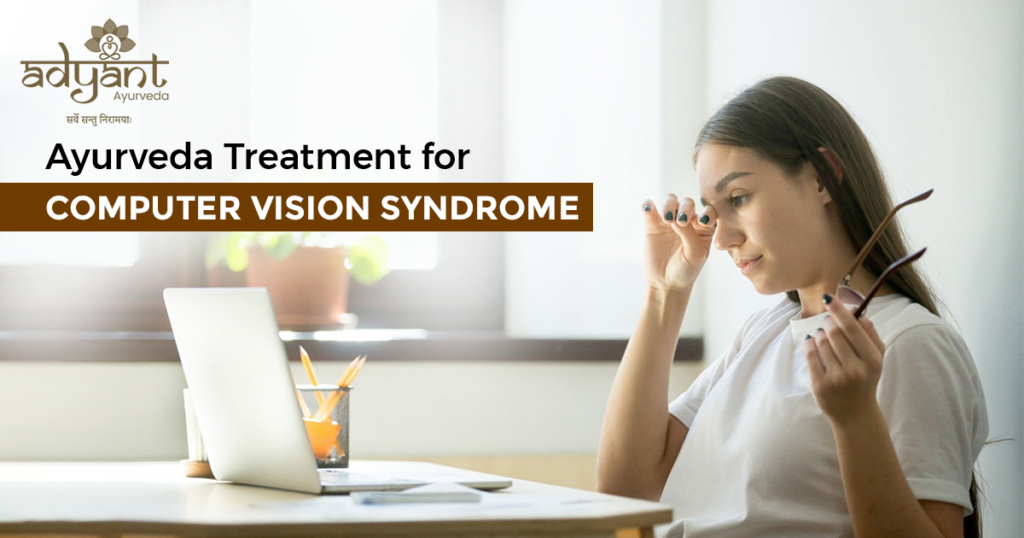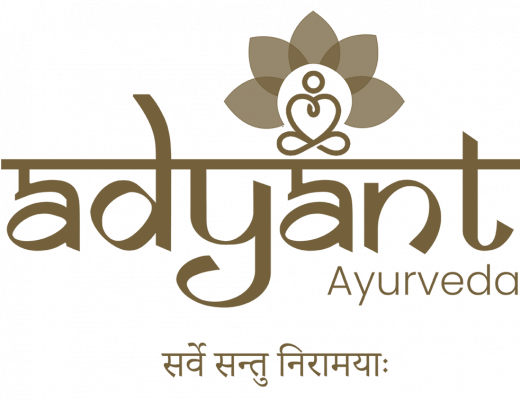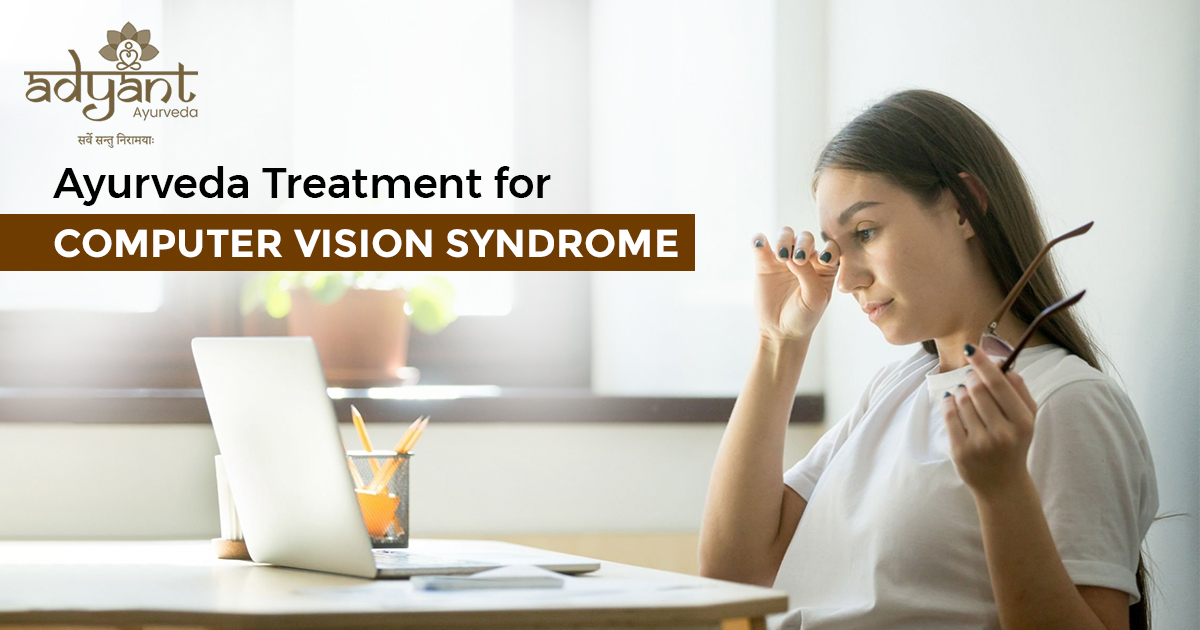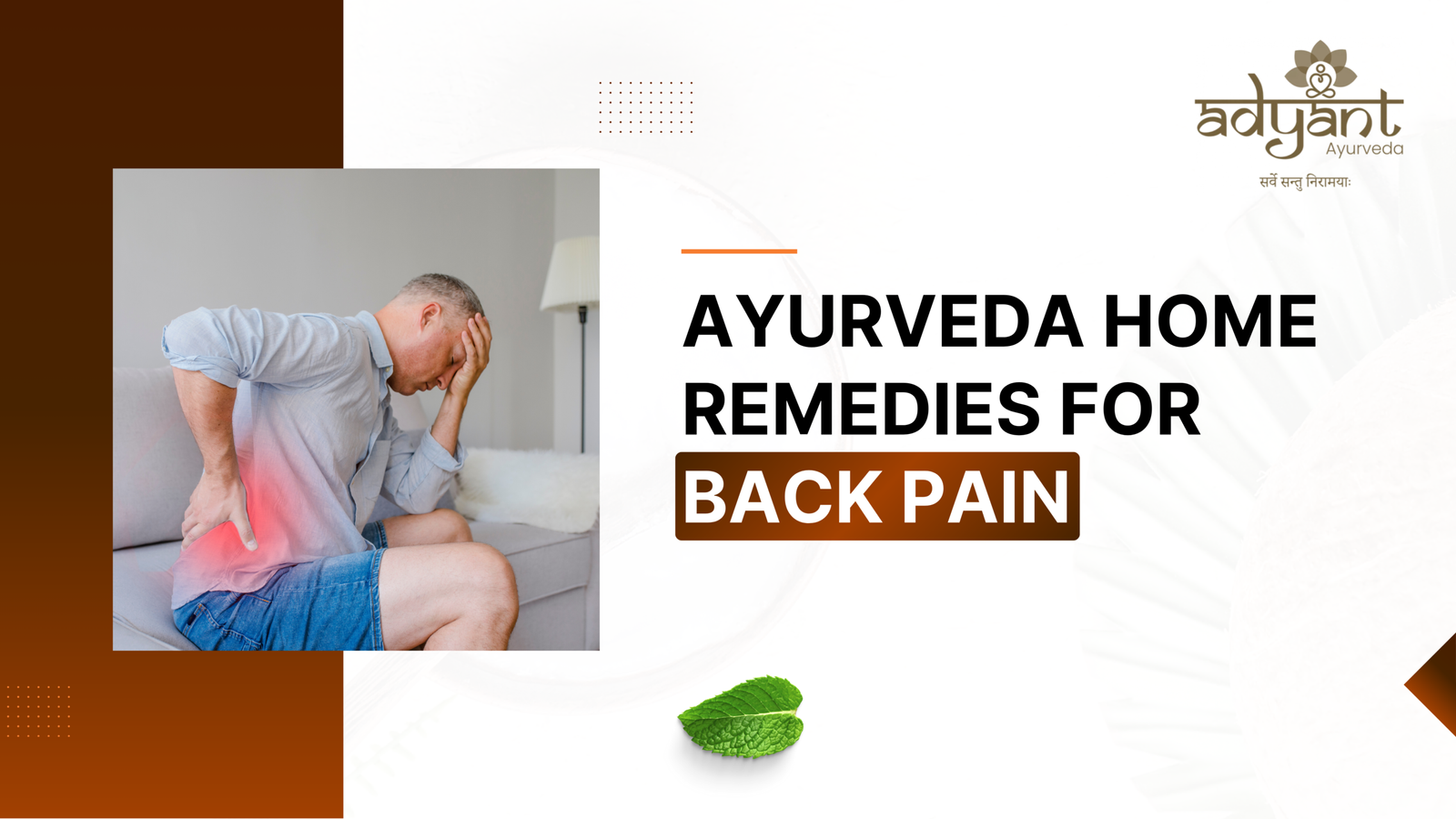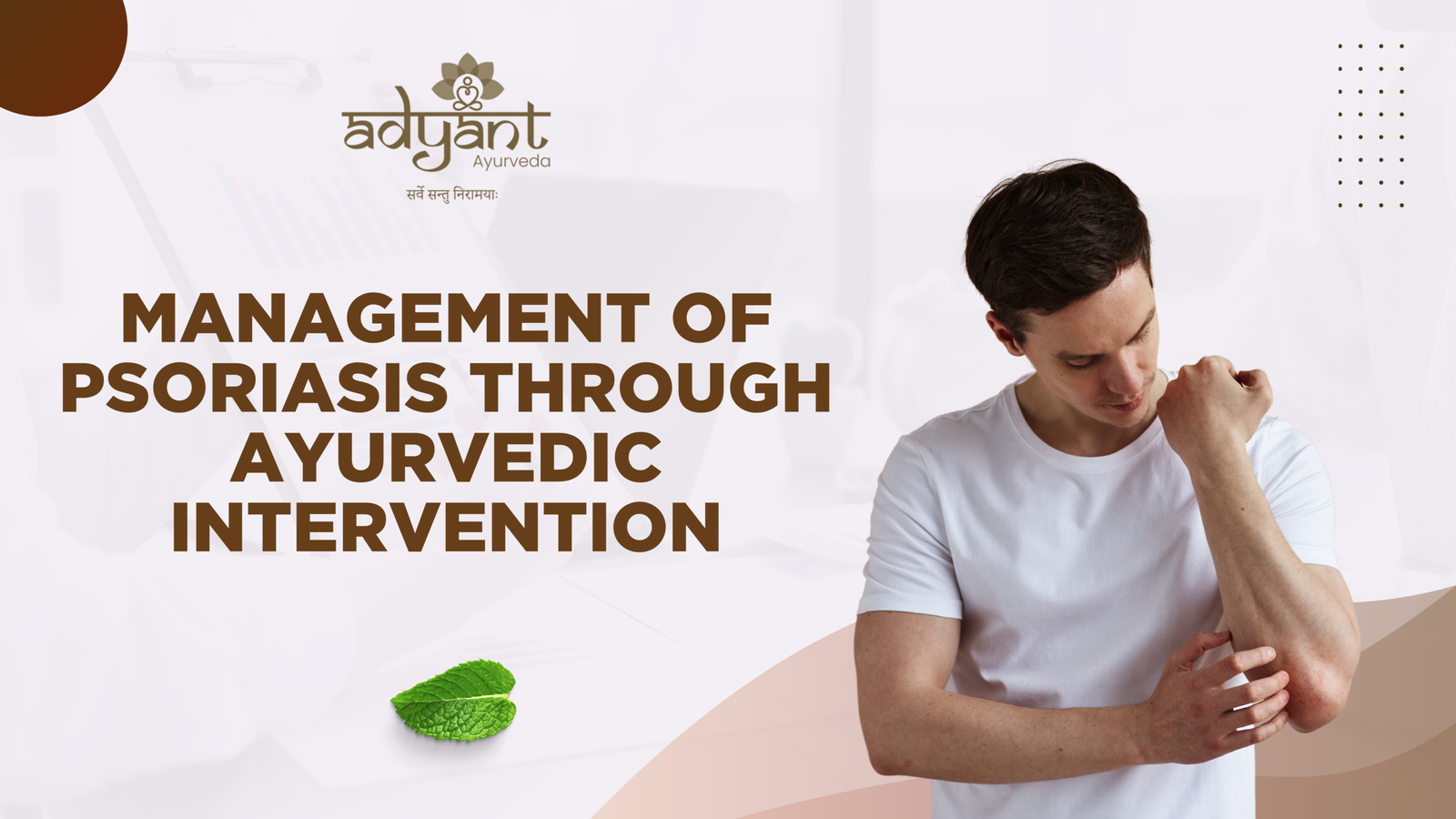Table of Contents
Toggle🌿 Ayurvedic Treatment for Computer Vision Syndrome (Digital Eye Strain): Symptoms, Remedies & Therapies
Introduction
Ayurvedic Treatment for Computer Vision Syndrome (Digital Eye Strain) offers a natural, holistic approach to relieve eye fatigue, dryness, headaches, and blurred vision caused by prolonged exposure to screens. In today’s digital era, laptops, smartphones, and tablets have become an unavoidable part of work and leisure, but excessive use can cause Computer Vision Syndrome (CVS) — a growing occupational health concern worldwide.
According to the American Optometric Association, 50–70% of people who work on computers experience CVS symptoms. In India, a 2023 study revealed that nearly 68% of IT professionals suffer from digital eye strain. Without early intervention, this condition can affect productivity, sleep quality, and long-term eye health.
This article explores causes, symptoms, and the best Ayurvedic remedies, therapies, and diet tips — along with real patient success stories from Adyant Ayurveda, one of the leading Ayurvedic centers in Bangalore.
📌 What is Computer Vision Syndrome (CVS)?
Computer Vision Syndrome, also known as Digital Eye Strain, refers to a group of eye and vision-related issues caused by continuous screen time. It’s especially common among IT professionals, students, gamers, and digital content creators.
🔍 Causes of CVS
Prolonged screen exposure without breaks
Poor sitting posture and ergonomics
Blue light emissions are disrupting sleep and eye lubrication
Low screen brightness or harsh lighting
Infrequent blinking and a dry environment
Lack of physical movement and eye relaxation
👁️ Symptoms of CVS
Ocular Symptoms:
Eye dryness or watering
Redness, irritation, and burning sensation
Blurred or double vision
Sensitivity to light
Eye fatigue
Extra-Ocular Symptoms:
Headaches and neck stiffness
Back or shoulder pain
Mental fatigue, poor focus
Irritability and disturbed sleep
Reduced productivity
📜 Ayurvedic View on CVS
In Ayurveda, CVS is caused by the vitiation of Vata and Pitta doshas due to overstimulation of the eyes and nervous system. The Majja Dhatu (nervous tissue) and Rasa Dhatu (plasma) become weakened, leading to stress, dryness, and inflammation in the eyes.
Classical Reference: Sushruta Samhita, Uttara Tantra describes Abhishyanda, where Pitta aggravation leads to inflammation, dryness, and discomfort in the eyes — similar to the modern concept of digital eye strain.
🪷 Why Choose Ayurveda for CVS?
Unlike conventional treatments that only address symptoms temporarily, Ayurveda offers a root-cause approach by:
Balancing aggravated doshas
Nourishing and strengthening eye tissues
Calming the nervous system
Preventing recurrence through lifestyle changes
Providing side-effect-free solutions with herbal formulations
🛠 Step-by-Step Ayurvedic Treatment Plan for CVS
Initial Assessment – Pulse diagnosis (Nadi Pariksha) and eye examination
Internal Cleansing – Light Virechana if Pitta is high
Netra Tarpana Therapy – Daily for 7–10 days to nourish the eyes
Herbal Support – Triphala, Brahmi, Yashtimadhu, Ashwagandha
Lifestyle Modifications – Yoga, 20-20-20 eye rest routine, posture correction
Follow-up – Monitoring for long-term relief
🏺 Ayurvedic Therapies for CVS
| Therapy | Benefit |
|---|---|
| Netra Tarpana | Deep eye nourishment using ghee relieves dryness & strengthens vision |
| Netra Dhara | Herbal decoction wash reduces redness and irritation |
| Nasya | Clears sinuses, improves brain and eye function |
| Shiro Abhyanga | Head massage reduces stress, improves sleep and focus |
| Shirodhara | Streamed oil therapy calms the nervous system |
| Sthanika Abhyanga | Targeted massage for neck/shoulders; relieves posture fatigue |
| Pichu | Cotton-soaked oil therapy over the forehead relieves tension |
🌿 Internal Ayurvedic Medications (Under Medical Guidance)
Herb / Medicine Ayurvedic Name Key Benefits for CVS Usage / Form Triphala त्रिफला Improves eye health, reduces strain, and detoxifies eyes Powder or tablet; can also be used as a Triphala eye wash Amalaki (Indian Gooseberry) आमलकी Rich in Vitamin C, strengthens optic nerves, reduces oxidative stress Fresh fruit, juice, or powder Haritaki हरितकी Enhances vision, supports detoxification, and improves blood circulation to the eyes Powder or tablet Bibhitaki विभीतकी Reduces eye fatigue, supports tear production, and prevents dryness Powder or tablet Shatavari शतावरी Nourishes eye tissues, supports lubrication, and reduces dryness Powder, tablet, or capsule Punarnava पुनर्नवा Improves microcirculation, reduces puffiness around the eyes Powder or decoction Yashtimadhu (Licorice) यष्टिमधु Soothes eyes, relieves burning sensation, supports clarity of vision Powder mixed with milk or ghee Saptamrita Lauh सप्तामृत लोह Classical Ayurvedic formulation for improving eyesight and reducing strain Tablet or powder with honey/ghee Anjana with Sauviranjan अंजन Herbal collyrium that strengthens eye muscles and reduces strain Applied directly to eyes (under guidance) Mahatriphala Ghrita महात्रिफला घृत Medicated ghee that nourishes eyes, improves vision, and reduces strain Oral intake or Netra Tarpana therapy
🏡 Ayurvedic Home Remedies for CVS
Triphala Eye Wash – Soak 1 tsp Triphala overnight, strain, and wash eyes in the morning
Cow Ghee Consumption – 1 tsp desi cow ghee daily on an empty stomach
Cucumber & Rose Water Compress – Apply for 10 minutes to closed eyes
Castor Oil (Under Guidance) – 1 sterile drop in each eye at night
Herbal Tea for Detox – Boil coriander, fennel, and amla; drink warm
🧘 Lifestyle & Diet Tips to Prevent CVS
20-20-20 Rule: Every 20 minutes, look at something 20 feet away for 20 seconds
Blink often to restore the tear film
Maintain correct posture; screen at eye level
Practice Trataka and eye rotations daily
Stay hydrated with coriander/fennel/amla tea
Eat eye-friendly foods: carrots, spinach, ghee, soaked almonds
🍲 Ayurvedic Diet for Healthy Eyes
Include:
Carrots, spinach, amla, ghee, soaked almonds, walnuts, buttermilk, moong dal, coriander water
Avoid:
Spicy, oily, deep-fried, processed foods, and excessive caffeine
📌 Prevention Checklist for CVS
✅ Blink 15–20 times per minute
✅ Follow the 20-20-20 rule
✅ Adjust screen brightness
✅ Use anti-glare glasses if needed
✅ Practice daily eye yoga
✅ Keep body hydrated
💬 Real Patient Testimonials
“I had constant eye pain, fatigue, and sleeplessness from long computer use. After 10 days of Ayurvedic therapy at Adyant Ayurveda — especially Netra Tarpana and Shiro Abhyanga — I feel 80% better. I now work longer hours without strain.”
— Meghana K., 34, Graphic Designer, Bangalore
“Being a software developer, my eyes used to burn every night. After Ayurveda treatment, my headaches are gone and my eyes feel fresh even after coding all day.”
— Ravi S., 29, Software Engineer, Bangalore
Frequently Asked Questions (FAQs) on Ayurvedic Treatment for Computer Vision Syndrome (CVS)
1. What is Computer Vision Syndrome (CVS) according to Ayurveda?
In Ayurveda, CVS can be related to Netra Asrighata or Akshi Strain, where prolonged exposure to digital screens aggravates Pitta and Vata doshas, leading to eye strain, dryness, headaches, and blurred vision.
2. What are the common symptoms of CVS?
Eye strain or discomfort
Dryness and burning sensation in eyes
Headaches after screen use
Blurred or double vision
Neck and shoulder pain
Difficulty focusing on near or far objects
3. How does Ayurveda treat CVS naturally?
Ayurvedic treatment focuses on:
Netra Tarpana (medicated ghee therapy for eye nourishment)
Anjana (herbal collyrium application)
Nasyam (nasal drops for improved eye health)
Eye exercises and Trataka meditation
Dietary adjustments to balance Pitta and strengthen vision
4. What herbs are beneficial for CVS in Ayurveda?
Triphala – for detoxification and eye rejuvenation
Amalaki (Indian Gooseberry) – rich in Vitamin C for eye health
Yashtimadhu (Licorice) – soothes eye dryness and irritation
Bhringraj – improves blood circulation to the eyes
5. How long does it take to see improvement with Ayurvedic treatment for CVS?
Mild CVS symptoms may improve within 2–3 weeks with consistent therapies and lifestyle changes, while chronic cases may require 4–8 weeks of targeted Panchakarma and herbal support.
6. Can Ayurvedic treatment for CVS be done at home?
Yes, mild CVS can be managed at home with:
Daily Triphala eye wash
20-20-20 screen break rule
Applying ghee in the nostrils (Nasya)
Palming and blinking exercises
However, chronic cases benefit more from in-clinic therapies.
7. Is Ayurvedic treatment for CVS safe?
Yes, Ayurvedic therapies for CVS are safe when prescribed by a qualified Ayurvedic doctor. They use natural herbal formulations and gentle detox techniques without harmful side effects.
8. Does Panchakarma help with CVS?
Yes. Panchakarma procedures like Netra Tarpana, Nasyam, and Shirodhara improve eye lubrication, relieve strain, and restore ocular muscle health.
9. Can children and teenagers with CVS use Ayurvedic treatments?
Yes, Ayurveda offers gentle, age-appropriate therapies for children and teens with CVS, especially herbal eyewashes and dietary changes, to protect developing eyes.
10. Where can I get Ayurvedic treatment for CVS in Bangalore?
Adyant Ayurveda, with branches in Jayanagar, Indiranagar, Kalyan Nagar, and Rajarajeshwari Nagar, offers specialized Ayurvedic eye care programs for CVS, combining traditional therapies with modern eye strain prevention strategies.
🌟 Why Adyant Ayurveda for CVS Treatment?
24+ years of Ayurvedic expertise in Panchakarma & Eye Care
Specialised in Netra Tarpana & advanced Ayurvedic ophthalmology
4 branches across Bangalore for easy access
Authentic classical herbs and in-house formulations
🏥 Visit Us – Adyant Ayurveda
📍 Branches: Kalyan Nagar | RR Nagar | Jayanagar | Indiranagar
📞 Call Now: +91 9972541009
🌿 Trusted by 10,000+ Patients
👩⚕️ Senior Ayurvedic doctors with 24+ years of experience in Panchakarma & Eye Care
🌟 Conclusion: Protect Your Eyes Naturally
In the modern world, your eyes face continuous digital stress. Ignoring symptoms like strain, dryness, or headaches can lead to chronic vision issues. Ayurveda offers a gentle, effective, and sustainable way to restore eye health and prevent recurrence.
💡 Don’t wait for your symptoms to worsen — take the first step towards natural healing today.
✍ Written by: Dr. Apoorva, BAMS – Ayurvedic Physician ( Written concerning Sushruta Samhita)
✅ Reviewed by: Dr. Shree Lakshmi, BAMS – Senior Ayurvedic Doctor, Adyant Ayurveda
